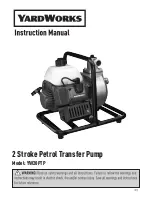
9
4.0 INSTALLATION - INDIRECT
UNITS
4.1 PLUMBING CONNECTIONS
The water cylinder requires the following pipework
connections.
•
Cold water supply to and from inlet controls.
•
Outlet to hot water draw off points.
•
Discharge pipework from valve outlets to
tundish
•
Connection to the primary circuit. Refer to the
Hydro Unit Installation Instructions for details.
Primary connections are 22mm compression. How-
ever, 3/4”BSP parallel threaded fittings can be fitted
to the primary coil connections if required.
4.2 ELECTRICAL SUPPLY (FIG. 6)
All units are fitted with a 2.75kW (230V) cylinder
heater and a thermal cut-out to supplement the Air to
Water heat pump primary heating.
The unit MUST
be earthed.
All wiring to the unit must be installed in accordance
with the latest IEE Wiring Regulations and the sup-
ply circuits must be protected by a suitable fuse and
double pole isolating switch with a contact separation
of at least 3mm in both poles.
ISOLATE FROM MAINS SUPPLY BEFORE
REMOVING ANY COVERS. DO NOT
BYPASS
THE THERMAL CUT-OUT IN ANY CIRCUM-
STANCES.
Ensure the thermal sensor and thermal
cut-out sensing bulbs are pushed fully into the pockets
on the element plate assembly.
All wiring to the unit must be via the controls housing
on the Hydro Unit. Direct connection of the cylinder
heater to the mains electrical supply will invalidate
the guarantee and may result in a dangerous instal-
lation. Refer to the wiring details in the Hydro Unit
Installation Manual.
The supply cable to the cylinder heater must be routed
through the right hand cable gland provided and the
outer sheath of the cable firmly secured by tightening
the cable gland. Connection must be to the terminal
block marked ‘TB03 (230V)’. The recommended
cable type is 2.5mm
2
3 core heat resistant sheathed.
The thermal sensor connection cable must be routed
through the left hand cable gland provided and the
outer sheath of the cable firmly secured by tightening
the cable gland. Connection must be to the terminal
block marked ‘TB06 (TTW)’. The sensor cable should
be 0.75mm
2
2 core and shield (ground) with a maxi-
mum current rating of 100mA. The cable shielding
wire must be connected to the terminal marked on
the sensor terminal block.
Thermal control of the water cylinder is managed by
the Heat Pump controls on the Hydro Unit. Refer to
the Hydro Unit Installation Manual for details of how
to set up the thermal control. The electrical supply
from Hydro Unit to the cylinder heater incorporates
an over temperature thermal cut-out that will switch
off the heater in the event of a thermal control failure.
The thermal cut-out must not be bypassed in any
circumstances.
5.0 COMMISSIONING
Warning:
Water that is left standing in a stainless
steel water cylinder for long periods without draw
off will become de-oxygenated and potentially cor-
rode the vessel material. If the installation is to be
left unused following installation and commission-
ing the water cylinder should be drained or regu-
larly (once per week) flushed through with fresh
mains water.
5.1 FILLING THE UNIT WITH WATER
•
Check Expansion Vessel pre-charge pressure. The
vessel is supplied pre-charged to 0.35MPa (3.5 bar) to
match the control pressure of the Pressure Reducing
Valve. The pre-charge pressure is checked using a car
tyre gauge by unscrewing the plastic cap opposite the
water connection.
•
Check all connections for tightness including
the cylinder heater. A cylinder heater key spanner is
supplied for this purpose.
•
Ensure the drain cock is
CLOSED.
•
Open a hot tap furthest from the water cylinder.
•
Open the mains stop cock to fill the unit. When
water flows from the tap, allow to run for a few min
-
utes to thoroughly flush through any residue, dirt or
swarf, then close the tap.
•
Open successive hot taps to purge the system of
air.
5.2 SYSTEM CHECKS
•
Check all water connections for leaks and rectify
as necessary.
•
Remove the Pressure Reducing Valve headwork
to access the strainer mesh, clean and re-fit.
•
Manually open, for a few seconds, each relief
valve in turn, checking that water is discharged and
runs freely through the tundish and out at the discharge
point.
•
Ensure that the valve(s) reseat satisfactorily.
5.3 PRIMARY CIRCUIT
Fill the primary circuit following the procedure de-
tailed in the Hydro Unit Installation Manual. Vent any
trapped air by opening the air bleed point or automatic
air vent.
Ensure the water cylinder is full of water before
switching on the Air to Water heat pump System.
Switch on the electrical supply to the heat pump and
ensure the programmer is set to HOT WATER mode.
Check that any motorised valves or primary pumps
are working and allow the unit to heat.
Содержание HWS-1501CSHM3-UK
Страница 15: ...15 NOTES...


































